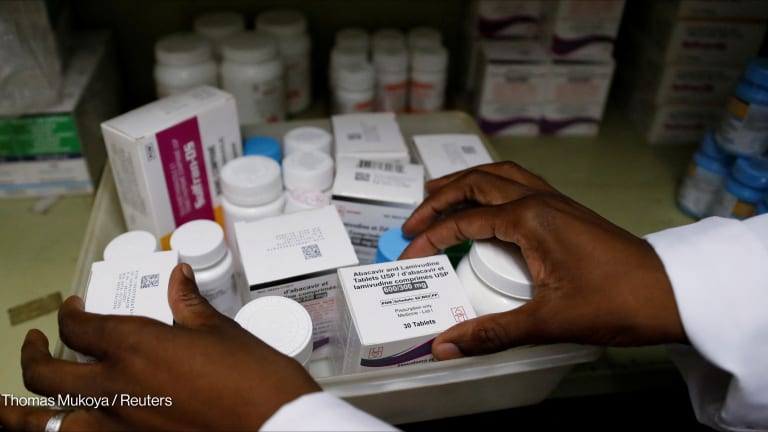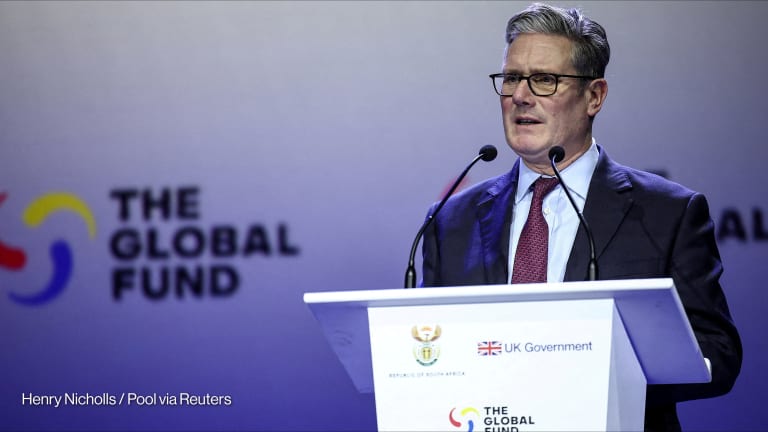The future of the Global Health Security Agenda
GHSA has multiple means to support countries in advancing their health security plans, according to its members, but these may need to be more visible for GHSA to maintain its relevance as new initiatives and recommendations come in for pandemic preparedness and response.
U.S. President Joe Biden allocated $1 billion in foreign aid for global health security and to bring an end to the COVID-19 pandemic in his proposed budget for 2022. Part of the funding is meant to expand pandemic preparedness efforts, including the expansion of capacity-building programs for the Global Health Security Agenda, an initiative born in 2014 during the presidency of Barack Obama. This signals the U.S administration's intentions to revitalize the GHSA, which was launched to help the implementation of the International Health Regulations. The idea was that it would identify gaps in countries’ abilities to detect and prepare for infectious disease threats and get high-level political support in countries to address those gaps, but it suffered from reduced funding from 2018. Some experts argue Biden’s renewed funding is not enough. GHSA needs dedicated, predictable, and sustainable financing that would allow countries to develop and implement their national health security action plans, according to Carolyn Reynolds, co-founder of the Pandemic Action Network. The U.S. government can strengthen it by working with other high-income countries and private funders to commit at least $10 billion for a multilateral financing mechanism for pandemic preparedness, she said, and they should make that commitment this year. “The U.S. government has rightly championed the Sustainable Financing Action Package under the GHSA, which has been doing good work, but it has not been prioritized among GHSA partners at the level it deserves. There is a political window to change this, and one that must be seized before the acute crisis fades from view in the U.S. and other wealthy nations,” Reynolds said. One of the often-mentioned limitations of the GHSA is financing. While the GHSA is not a funding entity, there was an expectation that it would be a means to facilitate funding once gaps are identified. But in reality, members are responsible for securing the financing they need, whether externally or through their own governments. “Our job is to make sure that when the high-level panels are over, when the inquiries have finished, that we don't stop, that we continue to take what we learned from this [pandemic] and carry them forward.” --— Julie Fischer, senior technical adviser for global health, CRDF Global What is GHSA’s value? Experts often attribute the introduction of joint external evaluations [JEE], which shifted reporting of countries’ preparedness capacities from self-reporting to independent — albeit voluntary — assessments and now led by the World Health Organization, as one of the biggest achievements of the GHSA. To date, 113 of these evaluations have been completed, and while COVID-19 has affected the conduct of these evaluations, a representative of the Thailand GHSA coordinating unit that currently serves as chair of the GHSA steering group, told Devex in an email that there are “multiple JEEs planned” in 2021. But the COVID-19 pandemic has put into question the effectiveness of the tool, and some have called for its review and revision. Countries such as the U.S., which scored high on preparedness under the JEE, struggled in responding to COVID-19 and had recorded one of the highest death rates. The Thailand GHSA coordinating unit acknowledged that a good score on the JEE prior to the pandemic doesn’t guarantee a “good response.” “There are many factors involved and it is important to note that every country does have a unique situation,” according to the unit’s representative, who added, “COVID-19 has shown that the response requires more than showing demonstrated or sustainable capacity in those technical areas. Those capacities described in JEEs are a vital foundation but more is needed for a comprehensive, whole-of-society response.” The evaluations are not the end product. Countries are encouraged to develop fully costed national action plans for health security [NAPHS] — basically a framework through which countries identify the next steps to fill the gaps in their health security systems. That means that countries need to put in place an electronic surveillance reporting system and include how much that would cost in the plan. The GHSA also keeps track of countries’ progress in at least five technical areas they have chosen to prioritize, with a focus on prevention, detection, and response. These include, for example, preventing antimicrobial resistance or zoonotic diseases. But some countries have struggled to follow through on actions following an evaluation. Another achievement attributed to the GHSA, which members emphasized is voluntary, is having, to date, secured over 70 member countries as well as partner NGOs, businesses, and international organizations. While some see that as a limitation that has impacted the effectiveness of the GHSA, others pointed out that GHSA’s success shouldn’t be measured by the number of countries that have joined it. “It doesn’t need all countries to join, but to be successful going forward, the GHSA will need [to] attract and sustain high-level political support and financing,” Reynolds said. “It was envisioned to be at [the] head of state-level and we should get back to that vision.” The GHSA should also play a leadership role in ensuring the recommendations made by the Independent Panel for Pandemic Preparedness and Response, and commitments made by countries at the G-7, and the upcoming G-20, and U.N. General Assembly, translate into action, she added. GHSA has its strengths and has multiple means in supporting countries in advancing their health security plans, according to its members, although they’re not always easy to measure. “We've been standing and crying that the sky is falling ... since 2014. And then the sky fell, and now everyone knows the sky fell. What do we do? How do we stay relevant?” --— Julie Fischer, senior technical adviser for global health, CRDF Global The GHSA has established a platform for sharing lessons and best practices; created a networking space for technical experts from governments and organizations; and normalized the idea that governments should make tangible commitments to global health security that can be measured and tracked over time, according to Julie Fischer, senior technical adviser for global health at CRDF Global, and who handles communications for the GHSA Consortium of NGOs. These kinds of support don’t always get attention, and sometimes their only measure of success, such as in the case of networking, is in the form of anecdotal information, Fischer said. With the work of GHSA very much voluntary, many of them were spread thin during COVID-19. But she said there is a commitment over the next year for GHSA to systematically capture lessons and share them more widely. “It's not going to be flashy, it's not going to be a global launch of an international report … it may not be a press conference, but it will reach people who are in a position to actually be able to put those programs into place,” Fischer said. How can GHSA stay relevant? But amid the current wave of enthusiasm for pandemic preparedness and response, GHSA may need to be more visible to stay relevant. There’s already a host of new initiatives and recommendations announced in the past few months focused on how the world can better prepare for the next pandemic. “I think that's been frankly a challenge for all of us. How does GHSA stay relevant?” Fischer said. “I'm sure there's many fables about whatever we are now. We've been standing and crying that the sky is falling ... since 2014. And then the sky fell, and now everyone knows the sky fell. What do we do? How do we stay relevant? How do we redefine that?” she added. Fischer thinks there’s still a role for GHSA, which at the heart of it was built to raise awareness among decision-makers of the importance of preventing and preparing for exactly the kind of public health threat like COVID-19. While everyone is now aware of just how important preparedness is, GHSA has built “durable” partnerships among decision-makers in government ministries, such as in health and in finance, and they just need to “keep moving forward.” “Our job is to make sure that when the high-level panels are over, when the inquiries have finished, that we don't stop, that we continue to take what we learned from this [pandemic] and carry them forward and keep advocating and catalyzing and drawing attention across the public and private sector leadership ... and make sure that the highest-level decision-makers in governments, in the private sector and in the nongovernmental sector continue to push forward,” she added. The next 18 months could be an opportunity to assess the GHSA’s impact and future. “Currently the GHSA is slated to sunset at its 10-year mark in 2024; so the next 12-18 months is the right time for an inclusive process to assess the GHSA’s impact and the optimal structure for future engagement on global health security, whether it’s a GHSA 3.0 or a new entity,” Reynolds said.
U.S. President Joe Biden allocated $1 billion in foreign aid for global health security and to bring an end to the COVID-19 pandemic in his proposed budget for 2022. Part of the funding is meant to expand pandemic preparedness efforts, including the expansion of capacity-building programs for the Global Health Security Agenda, an initiative born in 2014 during the presidency of Barack Obama.
This signals the U.S administration's intentions to revitalize the GHSA, which was launched to help the implementation of the International Health Regulations. The idea was that it would identify gaps in countries’ abilities to detect and prepare for infectious disease threats and get high-level political support in countries to address those gaps, but it suffered from reduced funding from 2018.
Some experts argue Biden’s renewed funding is not enough. GHSA needs dedicated, predictable, and sustainable financing that would allow countries to develop and implement their national health security action plans, according to Carolyn Reynolds, co-founder of the Pandemic Action Network.
This story is forDevex Promembers
Unlock this story now with a 15-day free trial of Devex Pro.
With a Devex Pro subscription you'll get access to deeper analysis and exclusive insights from our reporters and analysts.
Start my free trialRequest a group subscription Printing articles to share with others is a breach of our terms and conditions and copyright policy. Please use the sharing options on the left side of the article. Devex Pro members may share up to 10 articles per month using the Pro share tool ( ).
Jenny Lei Ravelo is a Devex Senior Reporter based in Manila. She covers global health, with a particular focus on the World Health Organization, and other development and humanitarian aid trends in Asia Pacific. Prior to Devex, she wrote for ABS-CBN, one of the largest broadcasting networks in the Philippines, and was a copy editor for various international scientific journals. She received her journalism degree from the University of Santo Tomas.








